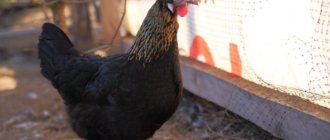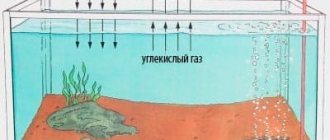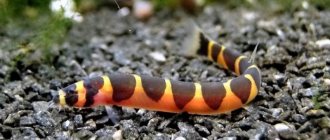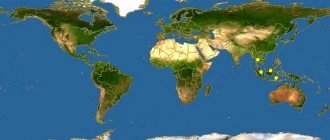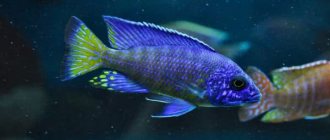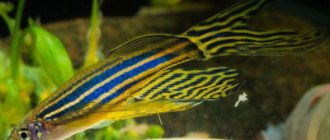The Russian muskrat is an extremely unusual animal, a prominent representative of the mole family. It is currently known that these creatures are a relict species, since they appeared on the planet approximately 30-40 million years ago. During this time, the animals remained virtually unchanged.
The Russian muskrat is an extremely unusual animal.
The Red Book has long been replenished with muskrats. For a long time, there was an active hunt for these small animals to obtain musk and high-quality warm fur. The widespread catching of animals led to their almost complete destruction. Only after measures were taken to protect animals of this species, their numbers increased slightly.
Anatomical characteristics of the Russian desman
In the process of evolution, this animal acquired a lot of properties suitable for a semi-aquatic lifestyle. It is believed that muskrats are the same age as mammoths, but unlike these giants, they have better adaptive abilities. The Russian muskrat, the description of which allows us to understand exactly how this creature lives, has much in common with its close relatives - moles. Many people who do not know what the animal looks like often confuse the two species. However, the mole and the muskrat live in different ecological niches, which determines the peculiarities of their structure. This creature is very modest in size.
The body length of the Russian desman is about 25 cm. The extended tail occupies approximately the same length. This part of the animal's body is very remarkable. Having a paddle-shaped tail, the tail helps the animal swim quickly. Fat reserves accumulate in this part of the body, which allow the muskrat to survive severe cold winters, when it is most difficult for an insectivorous creature to find food. In addition, such a tail gives the muskrat more maneuverability in the water and participates in heat exchange when the animal needs to quickly cool down. That is why this part of the body is not covered with water-repellent fur, but with hard scales. There are special scent glands near the tail. The weight of the Russian muskrat does not exceed 550 g. Females are usually smaller than males.
Description
The muskrat, or crest (lat. Desmana moschata) belongs to the mole family, from the order of insectivores. This is an amphibious animal that lives on land, but searches for prey under water.
The size of the khokhulya does not exceed 18-22 cm, weighs about 500 grams, and has a protruding flexible muzzle with a trunk-shaped nose. Tiny eyes, ears and nostrils close underwater. The Russian desman has short, five-fingered limbs with membranous septa. The hind legs are larger than the front ones. The claws are long, sharp and curved.
The animal's fur is unique. It is very thick, soft, durable and coated with an oily liquid to increase slip. The structure of the pile is surprising: it is thin at the root and widened towards the end. The color of the back is dark gray, the belly is light or silver gray.
The muskrat's tail, up to 20 cm long, is interesting; it has a pear-shaped seal at the base, in which glands are located that secrete a specific odor. Next comes a kind of ring, and the continuation of the tail is flat, covered with scales, and in the middle also with hard fibers.
Distribution area of the muskrat
Even 500 years ago, these amazing creatures were widespread throughout Europe. In most regions of historical habitat, muskrats are now extinct. Small populations of these creatures are found on river banks and in reservoirs in Ukraine, Kazakhstan, Lithuania and Belarus. Many muskrats are also found on Russian territory. Most of these creatures live in the Dnieper and Don basins. In addition, they are found in the upper reaches of the Volga. Currently, the number of Russian muskrats does not exceed 30 thousand individuals. These animals are significantly affected by deforestation, river drainage and environmental pollution.
The fur of muskrats is very unusual. The hairs are very thin on top, but the bases are thick.
The order of muskrats is small. In addition to the Russian, there is also the Pyrenean muskrat. The Red Book also includes this species. It has an extremely limited distribution area. This animal is found in rivers along the Pyrenees ridge on the border of Spain and France. Among other things, the Pyrenean muskrat lives in Central Portugal. This species is less endangered than the muskrat, which lives in Central Europe, since such creatures are smaller in size. They reach only 11-16 cm in length and weigh about 80 g, so hunting for them has always been less active. It is believed that the most favorable for muskrats are small bodies of water, as well as oxbow rivers, where there are low banks adjacent to the forest or overgrown with dense vegetation.
Population status and conservation
Currently, the muskrat can be preserved thanks to methods and non-traditional organizational forms. Namely, the creation of specialized hunting farms, the main principle of which is the rational use and protection of these animals.
Limiting factors
The habitat of the muskrat is small, since there are few bodies of water favorable for it. Natural factors that negatively affect its numbers include long-term winter floods and high water levels. When water rises in winter, muskrat burrows are flooded and they drown. During the dry summer, floodplain reservoirs become shallow and dry up, and muskrats have to look for a new place to live. On land, muskrats are practically defenseless due to their poor eyesight and slowness, although predators rarely eat them due to their strong musky odor. They are sometimes attacked by stoats, ferrets, otters, foxes, stray dogs and cats; Among the birds - marsh harrier, black kite, osprey, golden eagle, great spotted eagle, eagle owl, gray owl, even hooded crow and magpie. Underwater they are hunted by pike and large catfish. Wild boars tearing up the ground, and even grazing livestock, also harm muskrats. But the greatest pressure on them is exerted by introduced species - American mink and muskrat; the latter actively displaces the muskrat, occupying its burrows.
However, the main reduction in the range and number of muskrats occurs due to anthropogenic factors: net fishing, economic transformation of floodplains (drainage, water withdrawal for irrigation, deforestation), livestock grazing, and pollution of water bodies.
Economic importance and protection measures
In the past, the muskrat was a valuable commercial species. Until the third quarter of the 17th century, it was mined exclusively for its musky smell. In Rus', dried muskrat tails were used to rearrange laundry; Later, the secretion of her musk glands began to be used in perfumery as a fixative for the smell of perfume. Only later did muskrats begin to be hunted for their fur, and it was valued higher than beaver fur.
The ban on hunting muskrats was announced by the Soviet government in 1920 and was in effect for more than 20 years. During this time, the number of muskrats increased noticeably, and hunting was allowed again. However, in 1957 it was banned again, with the exception of catching animals for resettlement.
Russia has repeatedly taken measures to protect and restore the muskrat population. From year to year, more than 10,000 individuals were settled, including in the Novosibirsk (Tortas River) and Tomsk (Tagan River) regions, where muskrats had not previously been found. 4 reserves and 80 reserves of federal and local significance were created, where more than 30% of the total number of animals are concentrated. Since the fall, the Center for Wildlife Conservation, with financial support from the National Parks Foundation, has been implementing the “Save the Russian Muskrat” project, dedicated to assessing the current state of the muskrat population and developing measures for its conservation.
Number
Recording the number of muskrats in large areas is very difficult, and in recent years has practically ceased, so it is difficult to judge its numbers.
By this time, more than 70,000 muskrats lived in the USSR: of these, 69,000 individuals were in the RSFSR, 1,500 individuals were in Kazakhstan; in Ukraine and Belarus they amounted to just a few. In the early 90s. the number in Russia fell to 40,000 individuals, and another 2,000 individuals lived in Kazakhstan. Now the number of the species in Russia, according to expert estimates, is about 35,000 individuals, concentrated mainly in the basins of the Volga - 20,000 animals, and the Don - 10,000 animals. About 2,000 muskrats live in the Dnieper basin. They are few in number in the Ural basin. In the Ob basin, the animal appeared thanks to artificial resettlement and is currently most numerous in the Kurgan region (2000 individuals) and very rare in the Tomsk and Novosibirsk regions, where its numbers have fallen due to high floods and weak protection.
Gallery: Russian muskrat (25 photos)
How do muskrats live in their natural environment?
Many interesting facts about the peculiarities of the life of these creatures have become known relatively recently. Although muskrats are air-breathing mammals, they spend most of their lives underwater. These animals are semi-aquatic animals and have not yet lost their urge to dig holes. They find a suitable place near the shore, where they create a hole, the length of which can be from 1 to 10 m. The entrance is always under water, which serves as excellent protection from predators. The burrows are usually highly branched. In the soil thickness they create several chambers with air and nests, which are usually located at a distance of at least 30 cm from each other.
Family groups of these creatures usually dig additional holes, the length of which does not exceed 1 m. They are a chamber filled with air and having a wet litter. Muskrats need such burrows not only for resting in the summer, but also for living under the ice in the winter. In additional burrows, the animals replenish their air reserves when they cannot appear on the surface. Despite its extremely modest size, an animal such as the muskrat is an extremely voracious creature, as it has a fairly fast metabolism. His diet includes:
- leeches;
- worms;
- shellfish;
- small fish;
- tadpoles;
- frogs;
- larvae;
- rhizomes of plants.
The musky smell attracts prey, so the Russian desman is rarely left without food. In summer, these creatures try to retire. This improves the chances of finding enough food. When reservoirs dry up, life for muskrats becomes very difficult. On land, these creatures are clumsy and often become prey for wild cats, otters, ferrets, foxes and other predators. Due to their fast metabolism, animals cannot hibernate during the cold period. They often gather in flocks. More than 10 individuals can winter in one burrow.
Nutrition
The diet of the muskrat is not particularly varied. The main diet of these animals consists of insect larvae, mollusks and leeches. In winter, this list is replenished with all kinds of plant foods and even small fish.
Although the muskrat is not large in size, it eats quite a lot - in a day an adult eats an amount of food equal to its own weight. The method of obtaining food during winter is quite interesting.
When a muskrat moves from one hole to another along a dug trench, it gradually exhales the collected air, leaving behind a string of small bubbles. These bubbles, rising, accumulate under the thickness of the ice and freeze into it, making the ice fragile and porous.
These porous areas create conditions for the best air exchange, which attracts mollusks, fry and leeches, which become easy prey for muskrats.
It is also possible that the smell of musk is attractive to aquatic inhabitants. The source of this smell is an oily musk secreted from glands located in the first third of the muskrat's tail.
Thus, the animal does not have to regularly rush along the bottom in search of food - the food itself is drawn to the trenches along which the muskrats regularly move.
What is the breeding season like for Russian muskrats?
With the onset of spring floods, mating games begin. In order to find a partner, the animals climb ashore and begin to make specific sounds similar to chirping. The males they attract often start fights to find out who gets the female. Pregnancy in these animals lasts about 2 months. Thus, at the end of May and beginning of June, from 1 to 5 babies are born in the nesting chamber. A newborn cub weighs only 3-5 g. It is naked and blind, so it needs constant attention from its mother. In some areas, these animals breed twice a year. The second peak in fertility occurs in November-December. The female remains with the young in the nesting chamber for the first 2 weeks. Then it may leave them for a short period. For the first 1.5 months of life, the cubs feed exclusively on fatty milk, which contains everything necessary for growth and development. The male is nearby and is guarding the burrow. At 1.5 months of age, young individuals begin to leave the den for a while and learn to find food.
By about 4-5 months, these creatures become completely independent. Young individuals of the Russian desman reach sexual maturity at the age of 10-11 months. The lifespan of animals in nature is only 4 years. In artificially created favorable conditions it can be extended to 5-7 years. However, in their natural habitat, these small semi-aquatic mammals have a lot of natural enemies, so even though muskrats reproduce quite quickly, many individuals die at a young age. To a large extent, these creatures are affected by human destruction of their natural habitat and pollution of water bodies.
More recently, special nurseries and reserves have been created, where scientists have the opportunity to study the behavior of animals and reproduce them in conditions close to natural, in order to then populate the territories that they previously inhabited.

